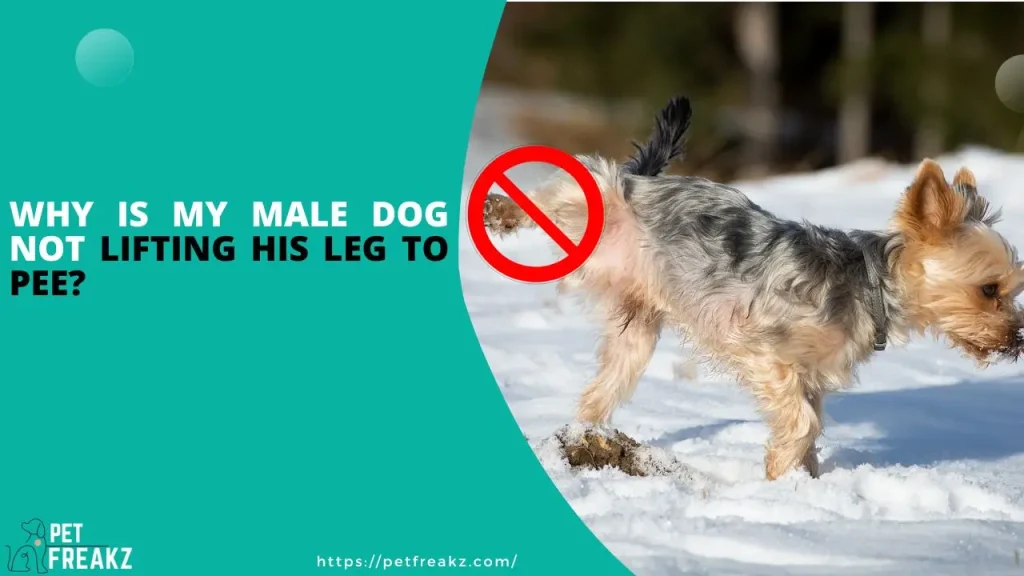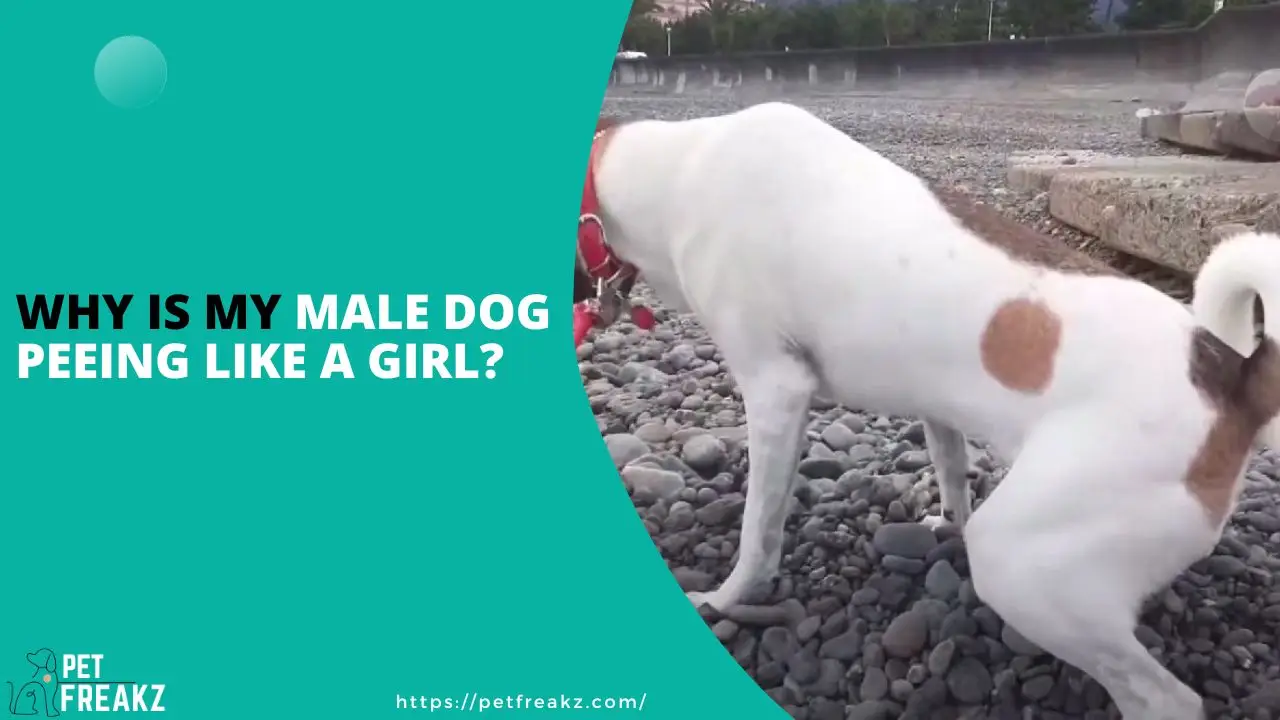Your male dog may be peeing like a girl due to a urinary tract infection, hormone imbalance or without any reason. This behaviour should be addressed by a veterinarian to determine the underlying cause and provide appropriate treatment.
Is your male dog suddenly peeing like a girl? This can be quite confusing for pet owners and may leave you wondering why this is happening. In most cases, male dogs urinate in a more distinct, leg-lifting manner, so when they start imitating the way female dogs pee, it can raise concerns.
While it may seem unusual, there are various reasons why a male dog may adopt this behaviour. We will explore the potential causes behind a male dog peeing like a girl and discuss the importance of seeking veterinary advice to address this issue effectively. By understanding the underlying reasons, you can ensure your furry friend stays healthy and happy.
Table of Contents
Understanding Male Dog Anatomy
Male dogs have unique anatomical features that contribute to their urination behaviour. Understanding these anatomical structures can help shed light on why a male dog may appear to pee like a female dog. Let’s delve into the anatomy of the male dog reproductive system and how urine is expelled in male dogs.
Normal Male Dog Urination Behavior
Male dogs exhibit certain urination behaviours that are considered normal. Here are some crucial points to keep in mind:
- Lifted leg: Male dogs often lift their leg to urinate, marking their territory and leaving a scent for other dogs. This behaviour is linked to their need to establish dominance and communicate with other canines.
- Scent marking: Male dogs have a gland called the anal sac, located near the anus. When a dog urinates, the liquid may contain pheromones from the anal sac, which serves as a means of communication with other dogs.
- Frequent marking: Male dogs tend to mark their territory more frequently than female dogs. This behaviour can be influenced by factors such as hormonal changes, social interactions, and stress levels.
Anatomy Of Male Dog Reproductive System
To understand why a male dog may appear to pee like a female dog, it’s crucial to grasp the anatomy of its reproductive system. Here’s an overview of the key anatomical structures involved:
- Penile sheath: The penile sheath is a protective covering for the male dog’s penis when it’s not in use. It helps maintain cleanliness and prevent damage to the sensitive tissues.
- Urethra: The Urine is transported from the bladder to the external opening through the urethra. In male dogs, it also serves as the pathway for semen during reproductive activities.
- Sigmoid flexure: Male dogs possess a sigmoid flexure, which is a natural curved structure in the penis. This flexure helps with erection and enhances the mating process.
Why Does My Boy Dog Pee Like a Girl?

Male dogs may sometimes exhibit behaviour that resembles peeing like a female dog. While it may seem confusing or unusual, there can be medical conditions underlying this behaviour. Identifying these conditions is crucial to ensure the health and well-being of your furry friend.
Let’s explore some common medical conditions that can affect male dogs’ urination.
Urinary Tract Infections (UTIs)
UTIs are bacterial infections that can affect the urinary system of male dogs.
Key points about UTIs:
- The bladder, urethra, and kidneys are all parts of the urinary system.
- Symptoms of UTIs in male dogs may include frequent urination, urinating in small amounts, straining to urinate, and blood in the urine.
- Utis can be caused by various factors, including bacterial invasion, anatomical abnormalities, or underlying diseases.
- Proper diagnosis by a veterinarian is important to identify and treat UTIs in male dogs.
- Treatment typically involves a course of antibiotics and sometimes supportive therapy to relieve symptoms.
Bladder Stones Or Crystals
Bladder stones or crystals can form in the urinary bladder and cause discomfort or obstruction to the flow of urine.
Key points about bladder stones or crystals:
- These stones or crystals can develop due to various factors, including diet, bacterial infections, or underlying metabolic disorders.
- Symptoms can include difficulty urinating, straining, frequent urination, blood in the urine, and sometimes behavioural changes.
- Diagnosis is usually made through physical examination, urinalysis, and imaging techniques like X-rays or ultrasounds.
- Treatment may involve dietary changes, medication, or in severe cases, surgical removal of the stones or crystals.
Remember, if you notice unusual urination behaviour in your male dog, it’s essential to consult a veterinarian for a proper diagnosis and appropriate treatment. Early detection and treatment of medical conditions can help ensure your pet’s well-being and prevent any further complications.
Hormonal Imbalances And Male Dog Urination
Male dogs have a complex hormonal system that plays a crucial role in their urinary habits. Hormones are responsible for regulating various bodily functions, including urinary behaviour. Understanding the role of hormones in male dogs’ urination can help shed light on why your furry friend may be peeing like a girl.
- Testosterone: Testosterone, the primary male sex hormone, has a significant impact on a dog’s urinary behaviour. It promotes the development of male reproductive organs and influences the marking behaviour, territoriality, and social interactions of male dogs.
- Estrogen: While estrogen is typically associated with female dogs, it can also be present in male dogs. Elevated levels of estrogen can occur due to certain health conditions or medications. These higher levels can affect a male dog’s urinary habits.
How Hormonal Imbalances Can Impact Urination
Hormonal imbalances can have a direct impact on a male dog’s urination and result in behaviours that are more commonly seen in female dogs. Here are some important points to consider:
- Increased frequency of urination: Hormonal imbalances can lead to increased thirst and subsequently more frequent urination. This can result in your male dog peeing more frequently, resembling the urinary habits of a female dog.
- Urinary tract infections: Hormonal imbalances can compromise your male dog’s urinary health, making them more prone to urinary tract infections. These infections can cause discomfort and pain while urinating, leading to changes in urination patterns.
- Urinary incontinence: Hormonal imbalances can also contribute to urinary incontinence in male dogs. This condition causes involuntary urination and can lead to dribbling or leaking urine, similar to how female dogs may experience it.
The Connection Between Hormone-Related Diseases And Urinary Behavior
Hormonal imbalances can sometimes be a sign of underlying hormone-related diseases, which can also impact a male dog’s urinary behaviour. Here are some crucial points to note:
- Cushing’s disease: Cushing’s disease, characterized by an overproduction of cortisol, can affect a dog’s urinary habits. Dogs with Cushing’s disease may experience increased thirst and urination, as well as urinary accidents.
- Diabetes: Diabetes in dogs can result in hormonal imbalances, primarily affecting insulin production. This hormonal disruption can lead to increased urination and eventual changes in urinary behaviour.
- Hypothyroidism: Hypothyroidism, caused by an underactive thyroid gland, can affect a male dog’s hormone levels. This condition may result in changes in urination frequency and volume.
Behavioural Reasons For Male Dog Peeing Like A Girl

Male dogs peeing like a girl can be a puzzling behaviour for pet owners. If your male dog is exhibiting this behaviour, it might be due to various behavioural reasons. Understanding these reasons can help you address the issue effectively and provide the appropriate training or support your dog needs.
Here are some common behavioural reasons for a male dog peeing like a girl:
Marking Behavior And Territory
- Dogs that are male have an instinctive desire to mark their territory.
- Marking behaviour involves urinating on objects or areas to establish their presence and communicate with other animals.
- Marking behaviour can occur regardless of gender, but in some cases, male dogs may squat while urinating, resembling female dogs. This behaviour can be triggered by encountering other animals’ scents or changes in the environment.
- To address marking behaviour, consider neutering your male dog, as it can help reduce the urge to mark. Additionally, providing regular exercise, consistent boundaries, and positive reinforcement training can help discourage this behaviour.
Submissive Urination
- Submissive urination is a common behaviour in dogs that display submissiveness or fear in certain situations. It typically occurs when a dog feels intimidated or threatened.
- Male dogs may exhibit submissive urination by squatting or dribbling urine when meeting new people, encountering dominant dogs, or experiencing stressful situations.
- To manage submissive urination, it’s important to avoid punishment or scolding, as it can exacerbate the behaviour. Instead, focus on building your dog’s confidence through positive reinforcement training, gradually exposing them to new experiences, and providing a calm and supportive environment.
Anxiety Or Stress-Related Urination
- Dogs can experience anxiety and stress like humans. Urinating like a girl can be a sign of anxiety or stress-related urination in male dogs.
- Anxiety or stress can be triggered by various factors such as separation, new environments, loud noises, or traumatic experiences.
- Addressing anxiety or stress-related urination requires identifying and minimizing triggers whenever possible. Providing a safe and comfortable space, incorporating positive reinforcement techniques, and potentially consulting with a veterinarian.
Understanding the behavioural reasons behind male dogs peeing like a girl can assist you in addressing any concerns or issues your dog may have.
Tips For Managing Male Dog Urination Problems

Male dogs peeing like a girl can be an unusual behaviour. While it may seem strange, if you’re experiencing this issue with your furry friend, don’t worry! There are effective ways to manage male dog urination problems.
Providing Regular Bathroom Breaks
- Establish a consistent bathroom schedule for your male dog. Let him go to the bathroom at regular intervals throughout the day.
- Make sure to provide him with plenty of opportunities to relieve himself outside, especially after meals, playtime, and naps.
- Allow your dog ample time to explore and sniff around during bathroom breaks, as this can help stimulate his need to urinate.
Proper Training And Behavior Modification Techniques
- Implement proper training techniques to reinforce appropriate urination behaviour. Reward your male dog when he urinates in the appropriate spot.
- Clean up any accidents promptly and thoroughly to eliminate lingering scents that may encourage repeat urination in unwanted areas.
- Consider using positive reinforcement techniques like treats and verbal praise to encourage desired toileting behaviour.
Why Is My Male Dog Not Lifting His Leg To Pee?

In this section, we’ll delve into the possible reasons why your male dog is not lifting his leg to pee. Understanding these factors can help you determine if the behaviour is normal or if it requires attention.
Age and Developmental Factors
It’s essential to consider your dog’s age and stage of development. Puppies, especially younger ones, might not lift their leg to pee. As they grow and mature, they often learn this behaviour by observing other male dogs in the household or during interactions with other canines.
Early Socialization

A lack of proper socialization during a dog’s formative weeks could influence their behaviour later on. If a male dog hasn’t been exposed to other dogs or had limited interactions with them during early life, they might not have learned certain behaviours, including lifting their leg to urinate.
Breed and Individual Variations
Interestingly, not all male dogs of every breed lift their leg to pee. Certain breeds tend to exhibit this behaviour more than others. Additionally, like humans, each dog has a unique personality and temperament, which may influence their urinary habits.
Dominance and Confidence
Lifting a leg to urinate is also associated with dominance and confidence in male dogs. If your furry friend lacks confidence or feels insecure, he might prefer to urinate in a more submissive position. Observing his overall behaviour and body language can provide insights into his confidence levels.
Health Issues
In some cases, a male dog not lifting his leg to pee could be a sign of an underlying health problem. For example, joint pain, arthritis, or an injury might make it uncomfortable for him to assume the typical leg-lifting position. If you notice any other signs of discomfort or changes in behaviour, consult a veterinarian to rule out potential health issues.
Neutering
Interestingly, neutering can sometimes influence a male dog’s urination habits. While it doesn’t happen in all cases, some neutered dogs might stop lifting their leg to pee after the procedure. This change could be due to hormonal adjustments or behavioural changes.
How Do You Train a Male Dog to Lift His Leg to Pee?

Training a male dog to lift his leg when peeing involves patience, consistency, and positive reinforcement. Here are some techniques, you can follow:
Setting the Right Environment
Creating a suitable environment for training is crucial. Choose a designated spot in your yard or a specific area during walks where your dog can comfortably lift his leg. This consistent location will help reinforce the behaviour and encourage your dog to recognize it as his territory.
Positive Reinforcement
Positive reinforcement is a powerful training tool. When your dog exhibits the desired behaviour, such as lifting his leg to pee, reward him with praise, treats, or affection. This positive association will encourage him to repeat the action.
Clicker Training for Leg-Lifting
Clicker training is an effective technique to associate the action of leg-lifting with a specific sound. Use a clicker to make a distinct noise when your dog lifts his leg to pee. Follow the click immediately with a treat or reward. Over time, your dog will associate the click with the behaviour you want to encourage.
Observing and Imitating Other Dogs
Dogs are natural imitators, and your furry friend may learn by observing other dogs. If you have access to a friendly and well-trained male dog, take your pup for a walk together. Watching the other dog lift his leg may encourage your dog to imitate the behaviour.
Using Scent Markers for Training
Scent markers can be beneficial during the training process. You can use a scent marker like a urine-soaked cloth or a commercial scent spray in the designated potty area. The familiar scent will attract your dog and encourage him to lift his leg to mark his territory.
FAQs For Why Is My Male Dog Peeing Like A Girl
Can A Male Dog Have A Urinary Tract Infection?
Yes, male dogs can develop urinary tract infections (UTIs). Common symptoms include frequent urination, difficulty urinating, blood in the urine, and odour. Utis can be caused by bacteria, bladder stones, or underlying health conditions.
What Are The Signs Of Bladder Stones In Male Dogs?
Male dogs may show signs of bladder stones, such as difficulty urinating, blood in the urine, frequent urination, and straining. Other symptoms may include discomfort, reduced appetite, and lethargy. Bladder stones can cause blockages, which can be life-threatening if not treated promptly.
Do all male dogs lift their leg to pee?
Not every dog lifts their leg to pee. Some male dogs may squat like females to urinate, especially when they are young or in certain situations.
Is it bad if a male dog licks a female’s pee?
It is not necessarily bad if a male dog licks a female’s pee; it’s generally considered a natural behaviour. Dogs use scent communication through urine, and licking it is part of their social and pack-related instincts.
What age do male dogs lift their leg to pee?
Male dogs typically start lifting their leg to pee between six months and one year of age. However, this can vary depending on the individual dog and its development.
Do dogs grow out of excited peeing?
Many dogs do grow out of excited peeing as they mature and gain better control over their bladder. Proper training and patience can help manage this behaviour during the transitional period.
Conclusion
Male dogs peeing like females can be a cause for concern for many pet owners. The phenomenon can have various underlying reasons. You need to consult a veterinarian if this issue stays for a long time.
The vet can conduct tests and examinations to determine the cause and offer appropriate treatment options. In some cases, the solution may involve medication or dietary changes. it is crucial not to ignore these signs, as early intervention can prevent further complications and alleviate your dog’s discomfort.





